
The smaller gold-mining and exploration stocks have enjoyed an amazing year, soaring with gold’s new bull market. Many have more than doubled since mid-January, and some have more than tripled at best in that short span. Are such spectacular gains fundamentally-justified, or merely the result of ephemeral sentiment that could vanish anytime? The gold juniors’ recently-reported Q1’16 results offer great insights.
The junior gold miners and explorers play a critical role in the world gold market. They bear the major costs and risks associated with discovering and sometimes developing new economically-viable gold deposits. They painstakingly find the new gold reserves to offset the constant depletion of the world’s existing gold mines, acting as the headwaters feeding the global mined-gold-supply pipeline vital to this industry.
The larger gold miners rely extensively on the juniors’ crucial exploration and early-development work to maintain and replenish their own operations. While the majors certainly do their own exploration, it is far from sufficient to offset existing gold mines exhausting. So gold juniors are constantly targeted by the larger miners, which acquire these companies outright, buy their projects, or partner with them for development.
These smaller gold miners and especially explorers are far riskier than the major gold miners. Gold juniors usually only have one operating mine or one major high-potential exploration project. With all their eggs often in one basket, they lack the major miners’ diversification across mines, projects, and their geopolitical jurisdictions. And naturally bearing much more risk, juniors must have higher potential returns.
It’s interesting to consider how juniors’ risk-reward dynamic has played out so far in 2016 in broad terms, through the lenses of the primary vehicles investors use to own precious-metals stocks. Today 3 leading ETFs dominate this industry. The GDX VanEck Vectors Gold Miners ETF includes the world’s biggest and best gold miners, the majors. At best between mid-January and late-April, it soared 107.1% higher.
The leading silver-stock ETF is the SIL Global X Silver Miners ETF, which naturally focuses on the elite silver miners. It skyrocketed a staggering 144.3% higher at best between mid-January and mid-May, trouncing GDX’s gains! Silver outperforming gold and silver stocks outperforming gold stocks is exactly what you’d expect. Silver is a much-smaller market than gold, effectively leveraging capital inflows into it.
And the last dominant gold-stock ETF is of course the GDXJ VanEck Vectors Junior Gold Miners ETF. Junior gold miners and explorers are much riskier than diversified gold or silver majors, so they should have higher returns to compensate. GDXJ has blasted an impressive 129.4% higher at best between mid-January and mid-May, so it has somewhat outperformed GDX but is lagging well behind SIL’s lead.
There are a couple likely reasons. Gold’s new bull market fueling these massive precious-metals-stock gains has barely begun after this metal slumped to a major 6.1-year secular low in mid-December the day after the Fed’s first rate hike in 9.5 years. Since gold juniors are riskier, they generally aren’t preferred early in bull markets when investors remain skeptical. Their popularity soars later as established bulls mature.
And as of the middle of this week, GDX, SIL, and GDXJ had net assets of $7.2b, $0.3b, and $2.7b. As SIL is so small compared to the much-better-known and established GDX and GDXJ, it takes less capital to catapult it higher. By the time we near the ends of these overdue mean-reversion bull markets in both gold and silver in a couple years or so, odds are the junior golds’ performance will again dwarf that of the majors.
As a speculator and investor, I need to understand which precious-metals stocks are likely to prove the top performers as gold and silver power higher. So after quarter-ends, I dig deep into the latest results of the world’s best gold and silver miners and explorers. These quarterly filings aren’t due until 45 days following quarter-ends, so I’ve spent recent weeks up to my eyeballs painstakingly analyzing dozens of 10-Qs.
The gold standard for precious-metals stocks is to be included in GDX, SIL, or GDXJ by their managers. These ETF companies have sizable dedicated research teams that wade through the many hundreds of precious-metals stocks out there to skim off the heaps of dross and uncover this industry’s best. So the component lists of these dominant ETFs are an excellent place to start when researching fundamentals.
Today’s essay is the third and final of a post-quarterly trilogy. Two weeks ago I dug into the GDX gold miners’ Q1’16 fundamentals in depth. Last week I applied a similar analysis to the SIL silver miners’ Q1’16 fundamentals. And now it’s the GDXJ junior gold miners’ and explorers’ turn. How did these companies actually fare in the first quarter, which was very important emerging out of Q4’s secular lows.
As of the middle of this week, GDXJ had a whopping 46 component companies! That’s problematic, heavily over-diversified. A smaller focused portfolio consisting of about 20 stocks with the most-superior fundamentals will greatly outperform a larger one padded with lesser stocks. I believe GDXJ’s investors would greatly benefit from a culling of this ETF’s excessive holdings. And it would actually be easy to do.
This week I looked at the top 34 GDXJ components’ Q1’16 quarterly reports filed by mid-May. That number fits in our standard-sized tables below. These 34 largest GDXJ component stocks accounted for 93.0% of this ETF’s total weighting. But as I analyzed them, I was struck by how many of these stocks are also included in GDX and/or SIL. These cross holdings seem counterproductive for all 3 of these leading ETFs.
Investors buy GDX because they want to own larger gold stocks, and GDXJ specifically for the smaller and riskier junior golds. They shouldn’t have the same holdings, as it is easy to make a distinction between larger and smaller gold miners. Both these ETFs are managed by the same company, so it would be pretty simple for their managers to agree on some definition to separate juniors from majors.
I’d make this production-based. If a company produced less than 200k ounces of gold over the latest 4 quarters for example, it could be considered a junior eligible for GDXJ inclusion if gold accounted for the majority of its trailing-twelve-month revenues. If a company produced more than 200k ounces over the rolling past year, it could instead be considered for potential GDX inclusion if gold was its primary business.
The holdings of GDX and GDXJ really should be mutually-exclusive, otherwise these ETFs are actively misleading investors with their names. I was very dismayed this week to find that 13 of GDXJ’s top 34 holdings were also included in GDX. Even worse, these 13 duplicate holdings accounted for a truly shocking 50.0% of GDXJ’s total weightings this week! GDXJ is now a half-GDX clone, not a junior vehicle.
VanEck runs both these ETFs and really needs to fix this so investors can have more-responsive options that hold true to these ETFs’ names and advertising. While VanEck doesn’t run SIL, I’d further argue that silver miners have no place in ETFs billed as gold-stock ETFs. 12 of GDXJ’s top 34 holdings are also included in SIL, and accounted for 35.7% of GDXJ’s weightings this week. But wait, it gets even crazier.
GDXJ’s top holding this week was the amazing First Majestic Silver, the world’s purest major silver miner as discussed last week in my look at SIL components’ Q1’16 fundamentals. And Pan American Silver, GDXJ’s fourth-largest holding this week, is the second-purest major silver miner that tops SIL’s recent weightings. Are investors buying an ETF specifically for junior golds wanting to own major silver miners instead?
And it’s not like GDXJ’s managers don’t actively manage its holdings. The differences between the weightings and even some of the companies between my last GDXJ analysis of Q4’15 fundamental data in early March and this week was enormous! With many dozens of excellent juniors to pick from out of the many hundreds out there, there’s no reason GDXJ should be laden with major gold and silver miners.
Nevertheless these GDXJ components are the definitive list of elite “junior golds”, so I dived into all of their Q1’16 reports just released by mid-May. Each of these top 34 components’ stock symbols, exchange listings GDXJ is using, GDXJ’s weightings as of this week, market caps, and P/E ratios are listed below. That’s followed by their cash costs and all-in sustaining costs per ounce in Q1’16, and full-year AISC guidance.
Next comes components’ cash balances at the end of Q1’16, cash’s percentage of their current market capitalizations, and first quarter’s cash flows generated from operations. Finally Q1’16’s production is listed in ounces. Numbers under 300k are gold, and all are in total equivalent ounces if reported by the companies for their primary metal. A gold miner also producing silver often converts it into gold-equivalent terms.
Thus if you compare these tables with my last couple essays on GDX and SIL components, there may be different production numbers. For GDX and SIL, I used pure gold and silver production whenever it was reported. But for GDXJ which is supposed to have a gold-junior focus, it made more sense to shift to gold-equivalent terms. If a company produced 0k ounces in Q1’16, it is still an explorer with no mining operations.
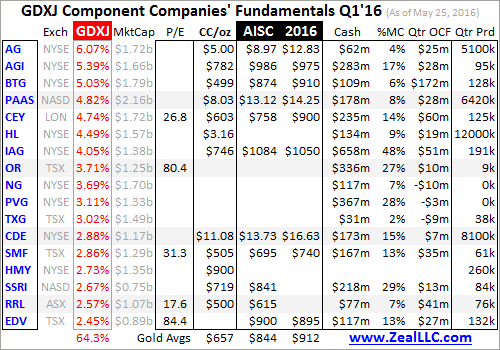
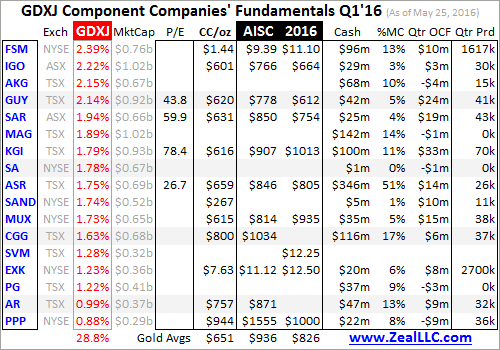
As the gold-stock “experts” CNBC brings on like to point out, the price-to-earnings ratios in this sector are crazy. The gold miners are either largely losing money or trading at extreme P/E ratios. But this critical valuation metric is very misleading today. As discussed in depth a couple weeks ago in my GDX essay, trailing-twelve-month GAAP earnings reflect large non-cash write-downs from last year’s secular gold lows.
Though such write-downs are required by accounting conservatism, they serve to obscure what is really happening on the operating front. Once those write-downs roll off the latest 4 quarters’ results, these trailing-twelve-month P/E ratios of the gold miners are going to collapse. I included this column today primarily as a reference for when this GDXJ-component fundamental research is furthered after future quarters.
Back in Q4’15 as gold slumped to that miserable 6.1-year secular low of $1051 by mid-December, its average price that quarter was just $1105. That was the worst seen since Q4’09! Such low gold prices fueled extreme bearishness, so junior golds’ stock prices were driven down to levels suggesting this whole industry was on the verge of bankruptcy. Somewhat paradoxically, Q1’16 wasn’t much of an improvement.
Though gold enjoyed a spectacular 16.1% rally in Q1, which was its best quarter since way back in Q3 1986, its average price still only climbed 7.3% to just $1185. Such levels still generate much unease, since as recently as last summer $1200 was erroneously believed to be the breakeven cost for the gold-mining industry. Yet again, the junior golds’ excellent Q1’16 operating results proved that was wildly off base.
Cash costs are gold miners’ acid test for survival, the breakeven level required to pay the ongoing operating expenses necessary to produce gold. They include all cash necessary to mine each ounce of gold. This includes all direct production costs, mine-level administration, smelting, refining, transport, regulatory, royalty, and tax expenses. As long as gold trades above cash costs, miners face no existential threat.
In Q1’16 the elite GDXJ gold juniors’ cash costs averaged just $654 per ounce! While that’s up 4.1% from Q4’15’s average, it’s still radically below not only prevailing gold prices but gold’s major secular low of mid-December. Gold could fall to an apocalyptic level of $700, which seems all but impossible given today’s bullish supply-and-demand situation, and the junior gold miners could still weather it for a long time.
And don’t read too much into that Q1’16 rise in gold juniors’ cash costs. My last essay on the GDXJ components’ Q4’15 fundamentals only had data current to early March. The filing deadline for annual reports ending fiscal years is 90 days, twice the usual quarterly 45-day one, due to the need for fully-audited financial statements and challenging-to-prepare comprehensive 10-K reports required by the SEC.
I did that last analysis before all the year-end data was in because there was still serious concern about the fundamental state of the junior gold miners then. So the Q4’15 numbers for the junior golds aren’t as comprehensive as these new Q1’16 ones gathered after all but two companies reported. South Africa’s Harmony Gold only reports in 6-month intervals, and Silvercorp Metals’ fiscal year ended on March 31st.
A more interesting comparison is the Q1’16 cash costs per ounce of the GDXJ components mining gold compared to the GDX components’ which averaged $583. It’s pretty impressive the juniors with their often-single-mine focus and non-existent economies of scale can operate at average cash costs only 12.2% higher than the elite majors’! The junior golds are doing an outstanding job managing their costs.
But cash costs are misleading, as it takes far more capital expenditures to run gold-mining companies as going concerns. All the gold mined is constantly depleting deposits, so new ones have to be found and developed to maintain current production levels. And old exhausted mines need to be reclaimed. So in June 2013, the World Gold Council introduced far-superior all-in sustaining costs to measure mining costs.
All-in sustaining costs include everything necessary to maintain and replenish gold-mining operations at current production levels. This includes all direct cash costs of mining gold, along with all corporate-level administration that always should’ve been included in cash costs. But AISC extend way beyond that to encompass the entire mining cycle, making them a far-more-realistic representation of true costs.
So AISC also include exploration for new gold to mine, the huge mine-development and construction expenses necessary to bring new mines online, remediation, and reclamation. As long as gold prices remain above all-in sustaining costs, the junior gold miners can continue to produce at current levels indefinitely. And GDXJ’s top 34 component companies reported impressively-low AISC in Q1’16.
They averaged just $893 per ounce, a massive $292 below the first quarter’s $1185 average gold price! That compares favorably with GDX’s top 34 components averaging $833 AISC in Q1’16. While it isn’t yet reflected in their P/E ratios, the elite junior gold miners are already very profitable. And they expect their AISC to fall considerably this year, with average 2016 projections running quite a bit lower at $866.
The primary thing that makes gold-stock investment so appealing is the great leverage to gold of these gold-mining profits. Gold-mining costs are largely fixed during each mine’s planning stages. That’s when mining engineers decide which ore bodies to extract, how to dig to them, and how to process that ore to recover the gold. So as prevailing gold prices rise, mining costs generally don’t climb along with them.
So far in Q2’16, gold has averaged $1253 per ounce. This is another 5.7% better than Q1’s average. And at $1253 gold and Q1’s $893 average AISC among the elite gold juniors, operating profits soar 23.3% to $360 per ounce. That’s 4.1x leverage to gold even on a minor move! Throughout the entire stock markets, stock prices ultimately migrate to some reasonable multiple of their underlying corporate profits.
The tough gold-price environment in recent years wasn’t normal, but an extreme anomaly driven by the Fed’s gross distortions of the financial markets. The last normal year for gold was 2012, which was not even particularly strong as this metal ground sideways to lower after peaking in 2011. Yet gold prices still averaged $1669 per ounce in 2012, a level they will almost certainly mean revert back to in the coming years.
Such totally-normal levels are highly likely again as the Fed’s artificial stock-market levitation inevitably fails and rolls over into the overdue new cyclical bear. Weaker stock markets will rekindle demand for alternative investments led by gold, which moves counter to stocks. Investors will flock back to gold for prudent portfolio diversification, something we’re already seeing this year. Regaining 2012 levels is no stretch.
At 2012’s average $1669 gold price and Q1’16’s average $893 AISC, gold juniors’ profits would rocket an incredible 165.9% higher on a mere 36.4% rally in gold from this week’s levels! This vast potential for extreme profits growth fueling radically-higher stock prices is why junior gold stocks are so alluring. The coming gains in this sector as gold mean reverts higher are going to be gigantic, multiplying investors’ wealth.
And Q1’16’s actual $292-per-ounce average operating profits among the junior gold miners prove that their stocks’ extreme early-2016 rally was indeed fundamentally-justified. Back in late 2015, this entire sector was left for dead and trading at apocalyptic fundamentally-absurd levels. The junior gold miners already enjoying big 24.6% operating margins on average in Q1 argues their mean reversion is righteous!
The already-wide gap between prevailing gold prices and all-in sustaining costs generally fueled strong cash generation from operations, as seen in the second-to-last column in these tables. The only gold juniors that didn’t see good operating cash flows were the ones ramping up new mines to commercial production and of course the explorers. Exploration-stage companies naturally have nothing to sell yet.
These strong Q1’16 operating cash flows from the junior golds boosted impressive treasuries across the top GDXJ components. Most were running large cash balances relative to their market capitalizations, at much higher percentages compared to the top GDX components. This not only protects these smaller gold miners from any normal healthy gold correction, but enables them to ramp capital spending to boost production.
So despite the serious skepticism remaining out there about the outlook for the junior gold miners, they really enjoyed an excellent first quarter operationally! Their fundamentals are strong, and the best of the smaller gold miners and explorers are well-positioned to greatly leverage gold’s mean-reversion bull-market gains in the coming years. Each quarter gold rallies on balance, their results will get better and better.
With both gold and silver in confirmed new bull markets for the first time since 2011, experienced investors who understand the risks inherent in junior gold mining and exploration should be looking into this high-potential sector. While owning GDXJ grants some exposure, it’s certainly not a pure junior-gold ETF thanks to the heavy weighting of larger gold miners and silver majors that its managers inexplicably include.
The greatest gains among the junior golds will come from the small miners and explorers with the best fundamentals. While GDXJ includes plenty of these, their collective weighting is relatively low. There are some GDXJ components that are amazing, and others I wouldn’t touch with a ten-foot pole. There’s no doubt an expertly-handpicked portfolio of the best gold juniors will trounce the future performance of GDXJ!
And deep research to uncover the best individual precious-metals-stock opportunities has been one of our specialties at Zeal for over 16 years now. Over the years our intense studies and active trading of this high-potential contrarian sector have yielded hundreds of gold-stock and silver-stock trades, helping our subscribers multiply their wealth. As this new gold bull has only begun, so have the gains in junior golds.
We’re now preparing for a big summer buying opportunity near gold’s seasonal lows, so it’s a great time to put us to work for you. We’ve long published acclaimed weekly and monthly newsletters enjoyed by contrarians worldwide. They draw on our vast experience, knowledge, wisdom, and ongoing research to explain what’s going on in the markets, why, and how to trade them with specific stocks. They will help you learn to think, trade, and thrive like a contrarian for just $10 an issue. Subscribe today while gold’s new bull remains young!
The bottom line is the junior gold miners’ fundamentals proved very strong in just-reported Q1’16. They were able to mine gold at all-in sustaining costs several-hundred dollars per ounce under the still-low prevailing gold prices. These low costs are already fueling excellent and surging operating margins, which will eventually be reflected in falling P/E ratios. The gold juniors are ready to greatly leverage gold’s bull.
Unfortunately most investors fail to take advantage of their enormous upside potential relative to gold early on. Junior golds are largely shunned early in new bulls when disbelief remains high. But that’s the best time to buy them low before they eventually grow popular again and their stock prices soar. As always, the smart contrarians who buy in ahead of the herd will enjoy the greatest gains in gold’s new bull.
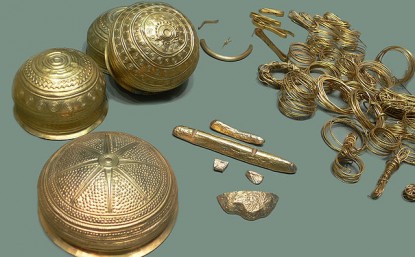
Last week, legendary hedge fund manager Stanley Druckenmiller recommended gold as the asset class to own and declared the “bull market in stocks is exhausted”. That’s just what I wrote four months ago. Druckenmiller asks “what was the one asset you did not want to own when I started Duquesne in 1981? Hint…it has traded for 5000 years and for the first time has a positive carry in many parts of the globe as bankers are now experimenting with the absurd notion of negative interest rates. Some regard it as a metal, we regard it as a currency and it remains our largest currency allocation.”
Today, we learn that another prominent hedge fund billionaire, Elliott Management’s Paul Singer, wrote in his latest letter to investors dated April 28 that the first quarter, gold’s best quarter in 30 years, “is probably just the beginning of a rebound as global investors weigh the ramifications of unprecedented monetary easing on.”
As reported by Bloomberg, Singer said that “it makes a great deal of sense to own gold. Other investors may be finally starting to agree….Investors have increasingly started processing the fact that the world’s central bankers are completely focused on debasing their currencies.” Further, he said that “if investors’ confidence in central bankers’ judgment continues to weaken, the effect on gold could be very powerful. We believe the March quarter’s price action could represent something closer to the beginning of such a move than to the end.”
Meanwhile, JPMorgan’s Solita Marcelli, Head of Fixed Income, Currencies and Commodities, told CNBC that after seeing three back-to-back years of losses, the precious metal has rallied 20 percent in 2016. “[We think] $1,400 is very much in the cards this year,” according to Marcelli. “Gold is a great portfolio hedge in an environment where the world’s government bonds are yielding at historically low levels,” he said.
As CNBC adds, gold will remain attractive in a world where bonds and U.S. rates may cease to be the main risk-off asset. “Gold is looking more and more attractive every single day,” Marcelli concludes. “As a non-yielding asset, it has a minimal storage cost, so when you compare it to negative-yielding assets, it actually has a positive carry.”
In a world with over $7 trillion in negative yielding bonds, finally someone else besides me has done the math.
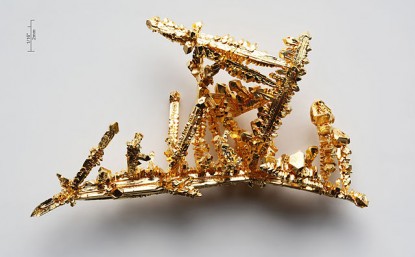
The gold-mining stocks have skyrocketed this year, radically outperforming every other sector. Smart contrarians who bought them low late last year and in January have seen their capital doubled, tripled, and even quadrupled! But such blistering gains raise the ominous specter of crippling overboughtness, conditions preceding major toppings. Have gold stocks come too far too fast to continue their epic run?
The magnitude of recent months’ gold-stock surge is simply stunning. Between mid-January and the end of April, this sector’s flagship HUI NYSE Arca Gold BUGS Index blasted 131.8% higher in merely 3.3 months! This was largely mirrored by the leading gold-stock ETF, the GDX VanEck Vectors Gold Miners ETF. GDX saw stupendous gains of 107.1% over this same span. Gold stocks have been on fire!
But naturally such fast gains have left this sector severely overbought by nearly every measure. That includes the moving-average convergence-divergence indicator, the distance of gold-stock prices above their 50-day moving averages, these same 50dmas’ gap over gold stocks’ 200dmas, and the lofty heights of gold-stock prices relative to their 200dmas. All these indicators also apply to gold-stock indexes and ETFs.
Any technician could easily make the case that gold stocks are positioned for an imminent collapse in light of their extremely-overbought technicals. In fact, that’s the only rational interpretation for analysts focusing exclusively on this sector’s current situation. But as always in the markets, broader context is absolutely essential. Making trading decisions without considering the bigger picture usually ends poorly.
The vast majority of market wisdom on overboughtness comes from major toppings. Extreme levels of overboughtness are famously seen after major bull markets running for years spark popular euphoria sucking in legions of new traders. If the gold stocks had just enjoyed a multi-year bull run to new record highs, and everyone was super-excited about them, then today’s extremes would be screaming sell signals.
But that’s not the case at all. Today’s extreme overboughtness comes after far-more-extreme anomalous secular lows. There’s no popular euphoria in gold stocks today, and certainly no major highs. Only a few months ago, no one beyond the most-hardened contrarians would even dare consider deploying capital in this left-for-dead sector. The current overboughtness was born out of crazy lows, not lofty heights!
Just like weather, the biggest price changes in the markets rapidly follow the greatest anomalies. The largest temperature shifts ever witnessed in weather data happen right after the most-unseasonable extremes. After near-record cold, the mean-reversion temperature swing back up to normal levels will be big and fast. Those resulting typical seasonal levels will be sustainable despite the extreme ramp bringing them.
Maintaining perspective in the markets is the key to overcoming the tyranny of the present over traders’ psychology, which usually leads to bad losing trades. When 2016’s incredible gold-stock surge is put back into the proper context of the months and years leading up to it, today’s extreme overboughtness has very different implications. Despite this sector rallying very far very fast, it is nowhere near topping.
In my decades of intense market research and speculation, I’ve found one of the best ways to measure how far how fast prices have moved is relative to their own 200-day moving averages. 200dmas aren’t static baselines that are soon rendered obsolete, they gradually evolve with price trends. And they work to thoroughly squelch the sometimes-serious volatility in prices, helping clearly delineate prevailing trends.
Many years ago I developed a simple trading tool called Relativity. It recasts prices as multiples of their own 200dmas, by dividing the former by the latter. When charted over time, these multiples tend to form horizontal trading ranges. They express the critical relationship between prices and their 200dma baselines in perfectly-comparable constant-percentage terms. Relativity actually quantifies “too far too fast”.
This first chart looks at the Relative HUI, or rHUI, in red. That’s just this leading gold-stock index’s close on any given trading day divided by its 200dma then. The actual HUI is superimposed in blue, along with some key technical lines including its 50dma, 200dma, and 2.5-standard-deviation Bollinger Bands. While gold stocks are extremely overbought, the context is the polar opposite from a major topping episode.
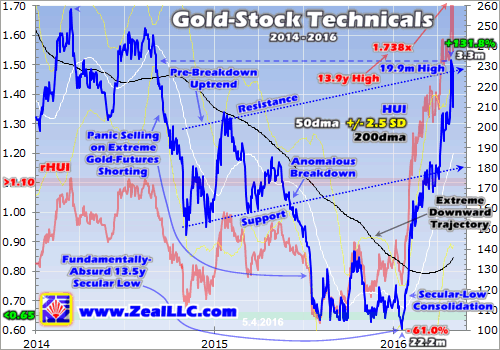
On April’s final trading day last Friday, the HUI blasted 7.2% higher to 233.5. That stretched this index to an astounding 1.738x its 200dma, in other words this sector was nearly 74% above that key baseline! Such extremes are exceedingly rare, that happened to be an incredible 13.9-year high in the rHUI. Out of 3612 trading days since 2002, the rHUI only exceeded 1.7x on 13 of them. That’s a third of one percent.
And until last Friday, every single one of these extreme rHUI readings showing extreme overboughtness happened in May and June 2002. And that was indeed a major topping, the climax of the enormous 310.7% initial bull run in the first 18.6 months of gold stocks’ new secular bull. But interestingly even in that example, the HUI merely consolidated sideways from there before surging to major new highs in mid-2003.
But I was actively trading gold stocks way back then, and certainly remember the euphoria as the HUI hit that extreme overboughtness. This small contrarian sector was growing popular among mainstream investors, as the general stock markets were trapped in the final months of a cyclical bear which would slash the broad-market S&P 500 index 49.1% lower over 2.6 years. That was a real gold-stock topping.
Today’s situation is radically different. Back in mid-July 2015, an extreme gold-futures shorting attack crushed gold so the HUI plummeted to a brutal 13.0-year secular low by early August. Then it ground sideways near those extreme lows until mid-January, when support at 105 briefly failed. That stretched the gold-stock sector as measured by the HUI to extremely-anomalous apocalyptic 13.5-year secular lows.
That very week I wrote a comprehensive essay on those extreme gold-stock lows, highlighting that they were truly fundamentally-absurd. The gold stocks were literally trading at prices last seen in July 2002. But back then gold was trading near $305, and had yet to exceed $329 in its young secular bull. And that January 2015 day saw gold trading 3.6x higher near $1087! Those gold-stock levels were supremely irrational.
Considered the other way, gold had fallen to a deep 6.1-year secular low in mid-December on Fed-rate-hike fears that history proves were totally unfounded. The last time gold had hit that very same $1050 level, the HUI was 3.7x higher. The gold-stock prices in mid-January were ludicrous, as the markets seemed to be betting that gold miners could only sell gold for 3/11ths of its prevailing price! It was sheer insanity.
That was one of the greatest pricing anomalies we’ll ever witness in our lifetimes, fueled by truly mind-boggling levels of prevailing fear. And it was that ultra-anomalous downside extreme from which this massive 2016 gold-stock bull was born. This year’s sharp gold-stock surge to today’s near-record levels of overboughtness wasn’t born in euphoria, but utter despair. It’s a righteous mean-reversion price swing.
The dominant reason gold stocks have come so far so fast is their pricing in January was so ridiculous. And today’s stretched technicals screaming warnings of severe overboughtness are the direct result of those downside extremes. If gold stocks hadn’t plunged so far so fast last summer, then languished at such crazy lows until January, their technical situation would look far different today as this chart shows.
The HUI’s 50dma was incredibly low before this latest gold-stock buying erupted, and its 200dma was in an extreme downward trajectory. So any measures of overboughtness based off these key moving averages are bound to show extremes. 200dmas in particular are so slow-moving that new bull markets often show severely-overbought readings in their initial months until their 200dmas finally reverse north.
Provocatively this even happened in the broader stock markets back in 2009 as their mighty new bull was born from the ashes of 2008’s first stock panic in a century. Later in 2009 the entire S&P 500 stretched an extreme 20%+ beyond its 200dma, levels that would normally signal a massive imminent selloff. Yet heeding such sell signals would’ve been a colossal mistake, as the stock market’s new bull would run for years.
When prices start mean reverting higher to rebound out of extreme lows, technical indicators often flash dire warnings of extreme overboughtness. This happens in the initial months of major new bull markets that will power much higher on balance for years. So this particular post-bottoming environment emerging from major secular lows is the exception to the rules of overbought indicators. This is true in gold stocks too.
Before we dig deeper into severe overboughtness early in massive new gold-stock bulls, it is also very important to consider the HUI’s absolute levels today. If gold stocks were now trading near major secular highs, which would naturally generate euphoria, then their overboughtness would indeed have grave bearish implications. But the HUI merely hit a modest 19.9-month high last week, not a 20-year one!
Gold stocks last traded at these levels in late 2014, before a couple bouts of panic selling on extreme gold-futures shorting. All the HUI has done in 2016 is regain its uptrend channel enjoyed in late 2014 and the first half of 2015 before last summer’s anomalous breakdown exacerbated by that extreme gold-futures shorting attack. So in absolute terms, gold stocks remain pretty darned low in the grand scheme!
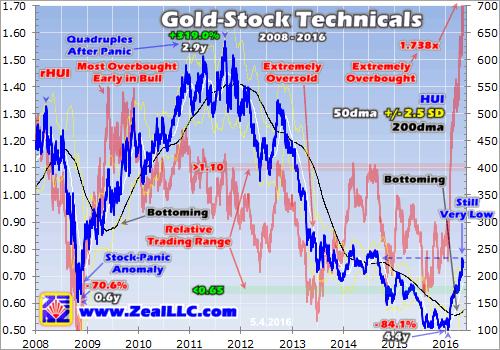
Back in early 2009 soon after gold stocks had started powering higher again, the HUI stretched up near 1.4x its 200dma multiple times. That’s fairly rare statistically too. Out of those 3612 trading days since 2002, the HUI only spent 154 above 1.4x its 200dma. That works out to 4.3%. I remember hearing the same arguments about gold stocks being dangerously overbought back in 2009 as well, portending a topping.
Yet much like today, by that point they had merely doubled on the way to a quadrupling. I just explained a few weeks ago why today’s gold stock bull is due for another easy double after already doubling by that point. The gold stocks looked very overbought technically in 2009 simply because they were mean reverting out of an anomalous downside extreme of major secular lows, moving averages hadn’t caught up.
Again 200dmas in particular take some time to turn. With calendar months averaging 21 trading days, a 200-day moving average encompasses fully 9.5 months of price action. So until a new bull market out of major secular lows passes the halfway point in this critical moving average, it still mostly reflects the downside price action leading into that secular low. 200dmas can’t keep pace with prices as bulls first ignite.
Thanks to their very gradual nature, it always takes some months for 200dmas to bottom, reverse, and turn north decisively. That lagging reversal period can’t reflect the intense buying common early in new bulls. Bull-market price trajectories generally follow a flattening parabolic path, like a ball being thrown up at a steep angle initially. Gains are fast in the first year or so, but then decelerate as the bull matures.
So somewhat paradoxically, the most-overbought levels in bull markets are usually seen in their first year. That was true of both gold stocks in their last bull, and general stock markets in theirs. Between 2009 and 2011, both HUI and S&P 500 Relativity multiples gradually moderated as those respective bull markets powered higher. By the times each peaked, they weren’t overbought at all on a technical basis!
With the exception of rare popular-mania blow-off tops, bull markets generally don’t die with readings of extreme overboughtness. Instead they gradually run out of steam as the supply of new buyers willing and able to commit more capital dwindles. So outside of that extreme mania situation, overboughtness has never been a good indicator of bull markets ready to give up their ghosts. It is actually an early-bull thing.
Still, today’s HUI way up at 1.74x its 200dma is far more extreme than the early-2009 overboughtness of 1.40x. But that’s misleading, a distortion from the technical lead-ins to both new gold-stock bulls. Back in late 2008, this sector’s secular-low extremes were very short-lived lasting mere weeks. That’s a sharp contrast from late 2015’s, which ran for 5.5 months. That long span of lows really dragged down the HUI’s 200dma.
Note in this chart how high the 200dma bottom was in early 2009 following late 2008’s fleeting extreme low compared to early 2016’s 200dma bottom after late 2015’s lingering lows. Since the HUI’s 200dma was dragged to anomalously-low extremes even by secular-bottoming standards as this year dawned, naturally the typical sharp early-bull gold-stock rally is going to stretch much farther above such lows.
And rather amazingly, 2016’s young new gold-stock bull was actually considerably less extreme than the one emerging from 2008’s stock panic! Back in late 2008 it only took the HUI 45 trading days, or 9 weeks, to double out of its extreme fear-drenched secular low. But in early 2016 the HUI took 57 trading days, more than 11 weeks, for that same initial double! Gold stocks advanced farther faster last time around.
So all gold-stock investors and speculators need to realize that the perceived extreme overboughtness of this sector today is misleading. Gold stocks have indeed come very far very fast in recent months, but they are nowhere near as overbought as the classic technical indicators suggest. Those very indicators remain heavily skewed by the abnormally-long period of gold-stock secular lows persisting late last year.
There is almost zero chance today’s extreme overboughtness heralds the end of this young gold-stock bull as some fear. In fact, just the opposite is true. The fact that gold stocks soared so far so fast in early 2016 to achieve severe overboughtness shows typical early-bull behavior. It suggests this new gold-stock buying is strong enough to persist for years, with capital inflows continuing to drive gold stocks higher.
That being said, overboughtness remains an important short-term indicator. Though May happens to be gold stocks’ strongest month of the year seasonally in bull markets, with an average HUI gain of 6.9% between 2001 and 2012, summer is coming. June and July are the weakest time of year for the entire precious-metals realm, the dreaded summer doldrums. Odds are gold stocks will drift lower as usual then.
So for investors and speculators worried about deploying more capital after such a blistering gold-stock rally, we may very well see better entry points towards late July if normal seasonals hold. While there is certainly no guarantee that normal market conditions will exist this summer with all the craziness in the markets this year, that’s what probabilities favor. A few-month consolidation would be very healthy for this bull.
Despite their extreme overboughtness and weaker seasonals ahead, the gold stocks remain radically undervalued relative to the prevailing gold price. That’s what drives their profits and thus ultimately their stock prices. At $1250 gold, the HUI would have to soar near 433 to merely mean revert to its post-panic average level relative to gold without overshooting. That’s more than a double even from this week’s levels!
While the HUI was indeed up a scary-sounding 110.0% year-to-date at last Friday’s peak, it had still only rallied 42.3% since the dawn of 2015 and a minor 18.1% since early 2014. A mere 40%ish sector rally unfolding across 16 months or 20%ish over 28 months wouldn’t even warrant a second glance by any technicians. Considered in broader context, today’s gold-stock levels are practically yawn-inducing!
That’s even more evident zooming out from this many-months perspective to a secular many-years one. This final chart looks at the HUI and rHUI since 2008, encompassing the last major gold-stock bull. This sector more than quadrupled emerging from those anomalous 2008-stock-panic lows, soaring 319.0% higher in 2.9 years. And provocatively gold stocks were the most overbought in that bull’s early months!
The bottom line is gold stocks are indeed absolutely overbought after skyrocketing in 2016. But this isn’t some dire bearish topping signal as feared. Technical overboughtness is actually common in young bull markets, since the moving averages haven’t yet had time to fully reverse and reflect the new trend. Severe overboughtness following major secular lows is actually a confirmation a new bull should run for years.
Gold stocks only look extremely overbought today because their recent major secular lows persisted for far longer than normal. That dragged their moving averages far lower than normal, greatly exaggerating recent reads on key technical indicators. But those will soon normalize. Gold stocks remain radically undervalued relative to prevailing gold prices today, so their mean reversions higher have a long ways to go.

Forex traders do not usually pay too much attention to commodities trading. While the two are connected (and some trade in both markets), one does not always spill into the other. However, when it comes to precious metals, foreign exchange trading is necessarily affected. Gold especially correlates with the strength of the US dollar – the currency in which it is priced.
For this reason, it’s important to be aware of the latest mining trends. Supply of precious metals is key to prices, which indirectly affects the Forex market.
Latest mining trends
For the past few years, mining trends have been somewhat the same. The industry is still finding ways to counter threats that have been hurting the value of the metals. The following 4 trends especially highlight the current movement of the mining industry:
1. Riding the waves of political uncertainty: while the industry is not as dependent on political stability as the Forex market, it still has a major impact on mining. Demand is higher in stable economies. The industry is therefore looking for a way to ride the waves of instability in China and the global markets.
2. Financing: equity investors have not been too eager to finance mining, with mining stocks consistently dropping since 2010.
3. Government engagement: government regulations in some regions make it difficult to set and meet expectations. The industry is still seeking the best strategy to deal with government intervention.
4. Innovation: mining is one of those industries that struggles with change. Miners are traditionally conservative, and need to start innovating in a corporate context to support growth. Emerging technologies are crucial to mining, and miners need to adapt to early adoption.
The Forex market
Foreign exchange trading is necessarily connected to these mining trends. Political uncertainty always impacts the Forex market, but so do resources. Decreased demand for resources in a region leads to a weaker currency, as investors seek commodities in other countries.
Government intervention impacts the markets on every level. The Forex market is closely linked to government regulations, as well as government decision making. Following the strategies used in mining will enlighten traders as to what to expect when the Forex market deals with similar engagement.
The mining industry’s struggle with innovation is also significant to the international Forex market. Currency exchange works on a moment to moment basis, depending on political and economic events around the world. Precious metals are equally affected by these events – but the mining industry is sluggish in finding ways to innovate and overcome obstacles. Thus, precious metals are left to the whims of the markets, and Forex traders need to be aware of this volatility.
Forex trading in the mining context
Foreign exchange trading is impacted by mining trends, but it’s important to remember that mining is not the only industry providing a context for foreign exchange. Forex is necessarily reliant on other industries and markets. Mining serves as one example of the demands placed on Forex traders. You have to keep an eye on global events, or you will miss good trades and make poor trades.
The latest mining trends have not changed much in the past few years, but they continue to impact the Forex market. If you are involved in foreign exchange trading, it is good advice to be on the ball in this context.
If you would like to receive our free newsletter via email, simply enter your email address below & click subscribe.
CONNECT WITH US
Tweets
Tweet with hash tag #miningfeeds or @miningfeeds and your tweets will be displayed across this site.
MOST ACTIVE MINING STOCKS
Daily Gainers
 Lincoln Minerals Limited Lincoln Minerals Limited |
LML.AX | +125.00% |
      |
GCR.AX | +33.33% |
      |
CASA.V | +30.00% |
      |
AHN.AX | +22.22% |
      |
ADD.AX | +22.22% |
      |
AZM.V | +21.98% |
      |
NSE.V | +21.05% |
      |
DYG.V | +18.42% |
      |
AAZ.V | +18.18% |
      |
GLA.AX | +17.65% |


 Follow us on Twitter
Follow us on Twitter Become our facebook fan
Become our facebook fan








